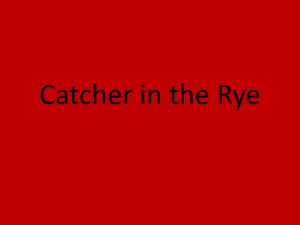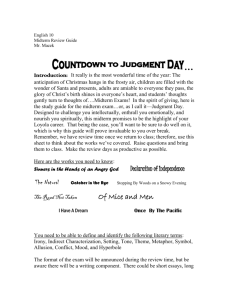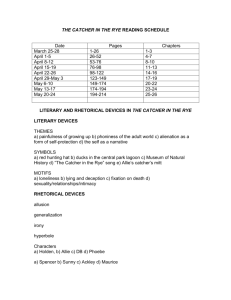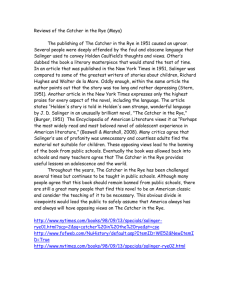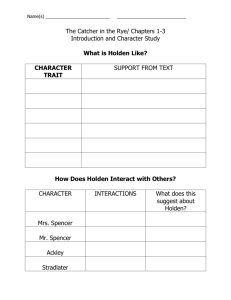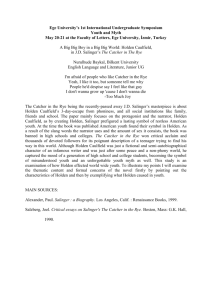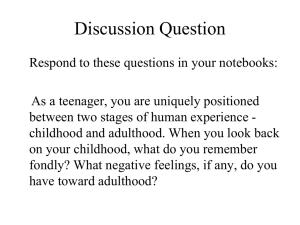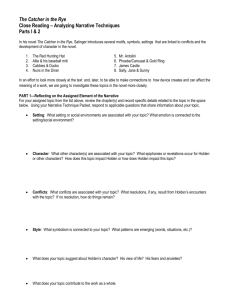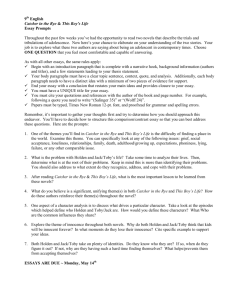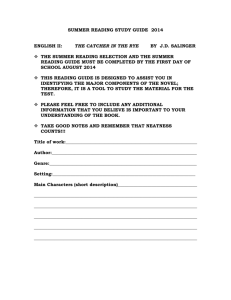Catcher in the rye plot
advertisement
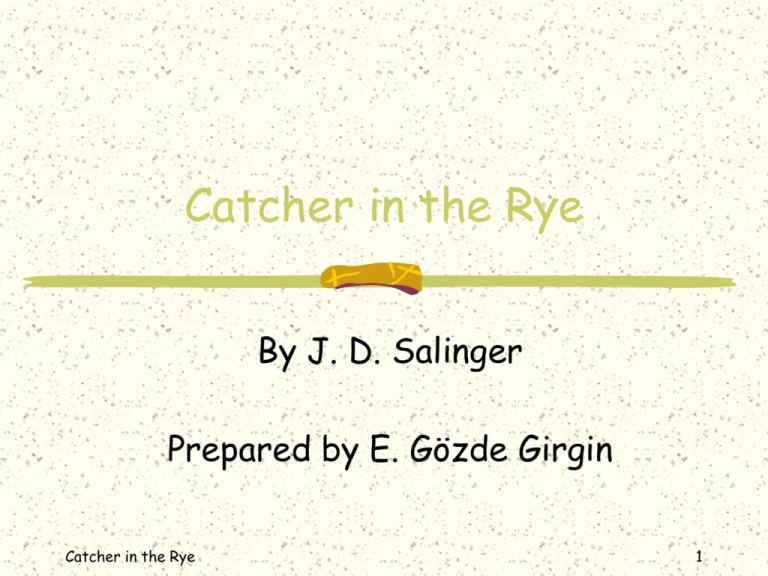
Catcher in the Rye By J. D. Salinger Prepared by E. Gözde Girgin Catcher in the Rye 1 INDEX: The Plot The Characters The Themes The Motifs The Symbols The Author Evaluation Catcher in the Rye 2 Objectives: To read a popular American novel by J. D. Salinger and evaluate the novel in terms of : To analyze the material in depth and answer discussion questions. The Plot The Characters The Themes The Motifs and Symbols. Catcher in the Rye 3 The Plot: Holden Caulfield, the narrator of The Catcher in the Rye, begins with the novel with an authoritative statement that he does not intend for the novel to serve as his life story. Currently in psychiatric care, this teenager recalls what happened to him last Christmas, the story which forms the narrative basis for the novel. Catcher in the Rye 4 Plot 2. Holden returns to his dormitory where he finds Robert Ackley *Holden tells about how Allie died of leukemia several years before and how he broke all of the windows in his garage out of anger the night that he died. Catcher in the Rye 5 Plot 3. Holden decides to leave Pencey He leaves Pencey to return to New York City, where he will stay in a hotel before actually going home. While he is walking he feels depressed when he hears children singing the song "If a body catch a body coming through the rye." When Holden sees Sally immediately wants to marry her, even though he does not like Sally. Catcher in the Rye 6 Plot 4. He tells Phoebe, whom he knows for some time that he would like to be "a catcher in the rye," and he imagines himself standing at the edge of a cliff as children play around him. He would catch them before they ran too close to the cliff. Catcher in the Rye 7 Plot 5. When his parents come home, Holden sneaks out to stay with Mr. Antolini, his former English teacher at Elkton Hills. Mr. Antolini tells Holden that he is headed for a serious fall and that he is the type who may die nobly for a highly unworthy cause. Holden falls asleep on the couch, and when he awakens he finds Mr. Antolini with his hand on Holden's head. Holden immediately interprets this as a homosexual advance, and decides to leave. Catcher in the Rye 8 Plot 6. Holden spends the night at Grand Central Station, then sends a note to Phoebe at school, telling her to meet him for lunch. He becomes increasingly distraught and delusional, believing that he will die every time he crosses the street and falling unconscious after suffering from diarrhea. When he meets Phoebe, she tells him that she wants to go with him and becomes angry when he refuses. He buys Phoebe a ticket for the carousel at the nearby zoo, and as he watches her, he begins to cry. Catcher in the Rye 9 Plot 7. Holden ends his story here. He refuses to tell what happened next and how he got sick, and tells how people are concerned about whether or not he will apply himself next year. He ends the story by telling that he misses Stradlater and Ackley and even Maurice. Catcher in the Rye 10 The Characters: Holden Caulfield Phoebe Allie Caulfield Mr. Spencer Mr. Antolini Ackley Catcher in the Rye 11 HOLDEN The protogonist of the novel and the narrator. He reveals himself to be self-destructive and dangerously cynical. Phobe Mr. Spencer Mr. Antolini Robert Ackley Holden's nine year old younger sister Holden's history teacher at Pencey, he discusses Holden's expulsion with him Holden's former English teacher Mr. Antolini allows Holden to stay with him A boorish, obnoxious student at Pencey He is social y inept Dr. Thurmer Allie Caufield The headmaster of Pencey, Dr. Thurmer gives Holden advice that "life is a game" Holden's younger brother he died from leukemia. Catcher in the Rye 12 The Symbols: 1)The “Catcher in the Rye” Catcher in the Rye 1) In Chapter 22, when Phoebe asks Holden what he wants to do with his life, he replies with his image, from the song, of a “catcher in the rye.” Holden imagines a field of rye perched high on a cliff, full of children romping and playing. He says he would like to protect the children from falling off the edge of the cliff by “catching” them if they were on the verge of tumbling over. 13 Symbols 2. 2)Holden’s Red Hunting Hat Catcher in the Rye The red hunting hat is inseparable from our image of Holden, with good reason: it is a symbol of his uniqueness and individuality. The hat is outlandish, and it shows that Holden desires to be different from everyone around him. 14 The Themes: Alienation as a Form of Self-Protection The Painfulness of Growing Up The Phoniness of the Adult World Catcher in the Rye 15 Alienation as a Form of Self-Protection Throughout the novel, Holden seems to be excluded from and victimized by the world around him. As he says to Mr. Spencer, he feels trapped on “the other side” of life, and he continually attempts to find his way in a world in which he feels he doesn’t belong. Catcher in the Rye 16 The Painfulness of Growing Up According to most analyses, The Catcher in the Rye is a bildungsroman, a novel about a young character’s growth into maturity. While it is appropriate to discuss the novel in such terms, Holden Caulfield is an unusual protagonist for a bildungsroman because his central goal is to resist the process of maturity itself. Catcher in the Rye 17 The Phoniness of the Adult World “Phoniness,” which is probably the most famous phrase from The Catcher in the Rye, is one of Holden’s favorite concepts. It is his catch-all for describing the superficiality, hypocrisy, pretension, and shallowness that he encounters in the world around him. Phoniness, for Holden, stands as an emblem of everything that’s wrong in the world around him and provides an excuse for him to withdraw into his cynical isolation. Catcher in the Rye 18 Motifs Loneliness Relationships, Intimacy, and Sexuality Lying and Deception Catcher in the Rye 19 Loneliness: Holden’s loneliness, a more concrete manifestation of his alienation problem, is a driving force throughout the book. Most of the novel describes his almost manic quest for companionship as he flits from one meaningless encounter to another. Catcher in the Rye 20 Relationships, Intimacy, and Sexuality: Relationships, intimacy, and sexuality are also recurring motifs relating to the larger theme of alienation. Both physical and emotional relationships offer Holden opportunity to break out of his isolated shell. They also represent what he fears most about the adult world: complexity, unpredictability, and potential for conflict and change. Catcher in the Rye 21 Lying and Deception: Lying and deception are the most obvious and hurtful elements of the larger category of phoniness. Holden’s definition of phoniness relies mostly on a kind of self-deception: he seems to reserve the most scorn for people who think that they are something they are not or who refuse to acknowledge their own weaknesses. But lying to others is also a kind of phoniness. Of course, Holden himself is guilty of both these crimes. His random and repeated lying highlights his own self-deception Catcher in the Rye 22 The Author: Born in New York City on the first day of 1919, J.D. Salinger is the son of a Jewish father and a Christian mother. After brief periods of enrollment at both NYU and Columbia University, Salinger devoted himself entirely to writing, and by 1940 he had published several short stories in periodicals. Although his career as a writer was interrupted by World War II, after returning Salinger resumed a writing career primarily for The New Yorker magazine. Catcher in the Rye 23 The Author 2. Salinger received major critical and popular recognition with The Catcher in the Rye (1951), the story of Holden Caulfield Salinger followed The Catcher in the Rye with Nine Stories (1953), a selection of his best literary work, and Franny and Zooey in 1961 Since 1953, Salinger has resided in Cornish, New Hampshire, and claims that he continues to write.. Salinger refuses to give interviews. Personal information about him is limited. Catcher in the Rye 24 Evaluation: 1. Holden narrates the story of The Catcher in the Rye while he is recovering from his breakdown. Do you think the promise of recovery that Holden experiences as he watches the carousel at the end of the novel has been fulfilled? Specifically, has Holden gained a more mature perspective on the events that he narrates? Catcher in the Rye 25 Evaluation 2. 2. Think about Holden’s vision of the nature of childhood and adulthood. Are the two realms as separate as Holden believes them to be? Where does he fit in? Catcher in the Rye 26 Evaluation 3. 3. Holden often behaves like a prophet or a saint, pointing out the phoniness and wickedness in the world around him. Is Holden as perfect as he wants to be? Are there instances where he is phony and full of hypocrisy? Catcher in the Rye 27 References: www.sparknotes.com www.gradesavior.com Salinger,J.D, Catcher in the Rye. United States, 1951. Catcher in the Rye 28 Thank You E. Gözde Girgin Catcher in the Rye 29
